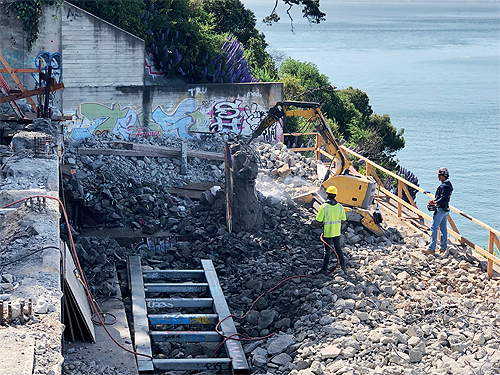
New approach
Belvedere’s Lava House, an unfinished and abandoned mansion with amazing views of San Francisco Bay and the iconic Golden Gate Bridge, was an irresistible draw for teenagers, thrill seekers and, more recently, social media users looking for an Instagram-worthy shot. With safety concerns mounting from deterioration and limited site access for emergency responders, though, property trustees stepped in to remove the iconic construction and stabilize the landslide-prone cliff face.
Up for the challenge
Jamba Construction, an award-winning local contractor specializing in unique and complicated projects, was tasked with finding a safe, efficient demolition solution. Steep terrain and a narrow site eliminated the option of large excavators and relying on smaller pneumatic equipment to demolish an estimated 1,000 cubic yards of concrete would be time consuming, dangerous and unnecessarily expensive. Excited for the challenge, Jamba turned to a revolutionary process gaining traction in the demolition industry — robotic demolition.
“We gravitate toward projects that require us to be innovative and to try new things,” said Mark Swanson, owner and president of Jamba Construction. “The Lava House definitely presented a challenge for our team, though. The property makes for an amazing view, but a bit of logistical nightmare when you need to arrange for equipment. We had two choices — by land or by sea — and neither one of them would be easy.”
Jamba contracted a landing craft to deliver a track loader with a grapple attachment and a ten-wheel dump truck to the beach area of the site as well as to remove debris by sea. The actual demolition would be bit more difficult, though. The narrow waterfront and difficult currents made it impossible to bring in the equipment necessary to work from below.
Accessing the property by land was also a challenge. Due to landslides and deterioration of existing structures, there was no driveway or clear path to access the site, preventing Jamba from simply driving in equipment.
Jamba was forced to come up with a creative solution to lower equipment from the street above. A narrow, two-lane road running across the top of the four lots created almost 400 linear feet of road access, but a low rock wall fronted the  property along most of that length. Additionally, a 60-degree incline just off the shoulder restricted access for larger equipment. In the end, Swanson and his team could only identify one 8-foot section with the access and tie-off points necessary to safely lower equipment 150 feet to the jobsite below. This meant they would need to find a small machine with the hitting power of a much larger excavator.
property along most of that length. Additionally, a 60-degree incline just off the shoulder restricted access for larger equipment. In the end, Swanson and his team could only identify one 8-foot section with the access and tie-off points necessary to safely lower equipment 150 feet to the jobsite below. This meant they would need to find a small machine with the hitting power of a much larger excavator.
Over the edge
So, Jamba partnered with a third party to operate a Brokk 160 remote-controlled demolition robot at the Lava House jobsite for one month. The demolition robot’s compact design and hitting power — comparable to that of a 4.5-ton excavator — was perfect for tackling the narrow passages and complex architecture.
After a thrilling descent where the Brokk operator worked in tandem with a 25-ton tow truck to lower the Brokk 160 to the jobsite, Jamba was ready to start the demolition phase of the 10-month project. Jamba crews worked to clear paths and backfill areas of the landslide-prone site to stabilize it while the Brokk operator hammered away at the concrete and lava structures. The Brokk machine was able to produce 300 foot-pounds of hitting power at up to 1,400 blows per minute using a SB202 breaker. The Brokk operator started demolition on the roof of the garage and steadily worked his way down, creating paths out of debris for the robot to maneuver to the next level.
In one month, the Brokk robot demolished 1,200 cubic yards of concrete and lava, completing 60 per cent of the overall demolition. Using a MB-L140 crusher bucket, Jamba crushed 1,000 cubic yards of concrete and lava for backfill to stabilize the site. An additional 1,000 cubic yards — along with 200 cubic yards of steel, wood and other materials — were removed by barge to recycling facilities in the Bay Area.
New beginnings
With the completion of phase one, the Brokk 160 was demobilized from the site and winched back up the slope. While they waited for cooler fall temperatures to start the landscaping phase of the project, Jamba completed demolition and debris removal with supplementary equipment.
“This project presented us with some exciting challenges,” Swanson said. “It also gave us a chance try out new technologies. We’re looking forward to more opportunities like this one.”
In less than one year, Jamba completed the multi-faceted demolition project. And, while the Lava House’s iconic structures might be gone, the million-dollar views remain.
Job Stats
• Location: Belvedere Island, Belvedere, Tiburon California
• Duration: 10-12 months
• Material Demolished: 1,500 cubic yards (estimated)
• Material Recycled: 1,400 cubic yards (estimated)
• Equipment: 1 Brokk160 Remote-Controlled Demolition Machine, 6-8 Handheld Breakers, Kubota SVL-75 high flow track loader with MB-L140 crusher bucketand Kubota KX040 9000lb mini excavator with demolition hammer
Jamba Construction is an award-winning general building and engineering contractor experienced in the construction of fine custom homes, estates and other innovative construction projects. The company also specializes in complex drilling, demolition and site engineering projects.
www.jambaconstruction.com
Brokk has been the world’s leading manufacturer of remote-controlled demolition machines and attachments for more than 40 years. Through continuous innovation in engineering and design, Brokk is able to offer unique solutions to multiple industries worldwide, including construction, demolition, mining and tunneling, cement and metal processing, nuclear and other specialty applications.
www.brokk.com